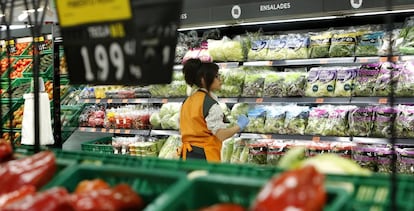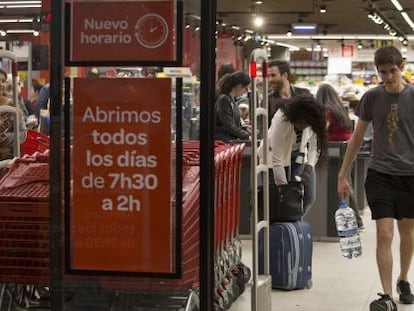Survey reveals Spain’s cheapest (and most expensive) supermarkets
According to a consumer group study, Alcampo is the nationwide chain that helps you save the most
Filling your shopping cart with similar products in your city’s cheapest supermarket or in the most expensive one can have major repercussions for your wallet. In Madrid, for example, the gap between the costliest and the cheapest establishments can equal €3,013 a year in savings, €14 more than last year.

The capital is among the Spanish cities with the largest price differences, according to a report by the Organization for Consumers and Users (OCU). On average, the report shows that in Spain the disparity between the cheapest and most expensive grocery chains is an average €909 a year on similar purchases.
In Alcobendas, a municipality outside Madrid, you can spend up to €7,329 per year shopping at the most expensive grocery store. On the other hand, buying at the most economical chain in the same town could save the family budget €2,850. In the Basque city of San Sebastián, the gap between the most expensive and the cheapest option is €1,502. In Santa Cruz de Tenerife, in the Canary Islands, €1,410 can be saved depending on where you choose to shop.
On average, the disparity between the cheapest and most expensive grocery chains is €909 a year
After Madrid, these are the cities with the most significant price differences, according to the OCU study. Granada, in Andalusia, is where filling the shopping cart is the least expensive, at about €4,051 per year, according to the same study.
The organization analyzed more than 164,000 prices at 1,137 establishments for 233 different products. Among them are 52 fresh foods (meat, fish, fruit and vegetables); 98 packaged food, drug and hygiene products selected among the leading market brands; and 83 cheap commodities, usually generic brands.
Segovia, Ciudad Real, and Pontevedra: Few savings options
The report shows that the average savings a consumer can get from switching from an expensive supermarket to a cheaper one is €909. This figure is 2.5% lower than last year, reflecting a reduction in the gap between grocery store prices. The average household spends €4,773 annually at supermarkets, making it possible to save 19% overall.
If the internet were a city, it would be in third place for possible savings after making the switch to a cheaper online supermarket, with net savings of €1,518 compared to the most expensive option. In the big cities and their peripheries, and in the Canary Islands’ capitals, having more options leads to larger savings. In contrast, in Segovia, Ciudad Real, (both in central Spain) and Pontevedra (in Galicia), the difference is more modest: €266, €344, and €343, respectively.
Alcampo, the cheapest chain
The report found that the cheapest establishment in Spain is Dani supermarket on Melchor Almagro street in Granada. The Alcampo store in Vigo, which was the cheapest last year, is now in second place, tied with three other Dani supermarkets also in Granada. The most expensive stores on the list are the three Sánchez Romero supermarkets in Madrid, followed by Sorli Discau in Barcelona.
On the podium for the cheapest national chains are Alcampo, Mercadona, Carrefour, Simply Market, Maxi Dia, Dia Market, Carrefour Market, Lidl, Eroski, and Dia Plaza. The most expensive national chains are El Corte Inglés, followed by Supercor, and Carrefour Express, among others.
According to the OCU, “Mercadona is the cheapest option in half of the cities that were studied, but if there is an Alcampo in the city, Alcampo is usually the most economical choice.” Lidl is the chain that has most increased its prices, by 4.3%. Maxi Dia increased them by 1.8% and Alimerka by 1.6%. The chains that have gotten less expensive are BM Urban at 3.2%, Lupa at 2.9%, and Más y Más at 2.3%.
Dani wins at the local level
The analysis found the Cash Fresh grocery store as the cheapest regional chain, above Family, Supercor, Consum, Bon Àrea, Cash Ecofamilia, E. Leclerc, Gadis Hiper, Superdino, and Gadis. Expect to spend more at these regional chains: Coaliment, followed by Suma, and Plus Fresc, among others.
The ‘discount’ change of face
The hypermarkets, or superstores combining food and other retail products, are the commercial format where it is cheaper to fill the OCU basket, according to the report. “Unlike previous years, hypermarkets are also the cheapest for generic brand goods, since the discount chains – such as Lidl, Dia, or Aldi – are changing their image to get closer to traditional supermarkets.”
Price of fresh goods increases almost everywhere
The average cost of the OCU basket has only increased 0.1% overall since last year. However, fresh products have been hit by the largest increases in almost all the chains: 5.3% at Lidl, 5.2% at Alimerka, and 4.3% at Consum, followed by 18 other chains. Prices have only gone down in Día Plaza, Urban BM, Simply Market, Supersol, Erosky, and Lupa. Rising prices of fresh goods have been offset, according to the OCU, by a decrease in generic brand prices.
As a whole, shoppers will spend the most in Barcelona, Teruel, and Palma de Mallorca and the least in Almería and Puertollano. Regionally, La Rioja and Galicia are the cheapest and Catalonia and the Balearic Islands the most expensive.
The cheapest supermarket in Spain
Surrounded by bookstores, stationery stores, and student gyms, the cheapest grocery store in Spain is situated just 100 meters from the College of Science at University of Granada. University students make up a majority of the clientele at Dani supermarket on Melchor Almagro street in Granada, where the aisles are full of sale markers. José Manuel, store manager for nine years, explains: “Students are the ones who give us life. During the school year they are our main customers. We notice their absence in July and August.”
As for what the students buy the most of, Manuel the manager did not need much time to answer. “Frozen foods, pizza, yogurts, and pastries ... lots of pastries. Older people do not seem to like the bakery so much.” For more traditional cooking ingredients the students stick to “chicken fillets or pork and that sort of thing.”
English version by Debora Almeida.
Tu suscripción se está usando en otro dispositivo
¿Quieres añadir otro usuario a tu suscripción?
Si continúas leyendo en este dispositivo, no se podrá leer en el otro.
FlechaTu suscripción se está usando en otro dispositivo y solo puedes acceder a EL PAÍS desde un dispositivo a la vez.
Si quieres compartir tu cuenta, cambia tu suscripción a la modalidad Premium, así podrás añadir otro usuario. Cada uno accederá con su propia cuenta de email, lo que os permitirá personalizar vuestra experiencia en EL PAÍS.
¿Tienes una suscripción de empresa? Accede aquí para contratar más cuentas.
En el caso de no saber quién está usando tu cuenta, te recomendamos cambiar tu contraseña aquí.
Si decides continuar compartiendo tu cuenta, este mensaje se mostrará en tu dispositivo y en el de la otra persona que está usando tu cuenta de forma indefinida, afectando a tu experiencia de lectura. Puedes consultar aquí los términos y condiciones de la suscripción digital.
More information
Archived In
Últimas noticias
Tiger Woods turns 50: Will he continue playing on the PGA Tour or take a back seat?
The surreal journey of James Nnaji, the Barcelona youth player selected in the NBA Draft who ended up in the NCAA
Trump claims peace in Ukraine is near, but Moscow suggests otherwise
A survivor’s account of the Interoceanic Train accident: ‘We were scared because of the speed on the curve’
Most viewed
- Oona Chaplin: ‘I told James Cameron that I was living in a treehouse and starting a permaculture project with a friend’
- Reinhard Genzel, Nobel laureate in physics: ‘One-minute videos will never give you the truth’
- Sinaloa Cartel war is taking its toll on Los Chapitos
- Why the price of coffee has skyrocketed: from Brazilian plantations to specialty coffee houses
- Chevy Chase, the beloved comedian who was a monster off camera: ‘Not everyone hated him, just the people who’ve worked with him’










































